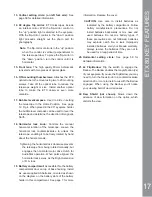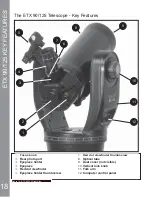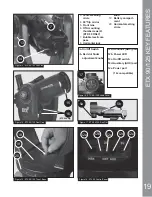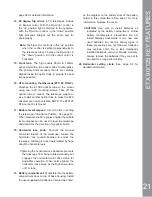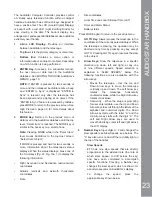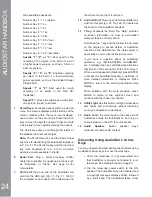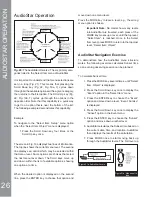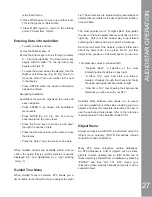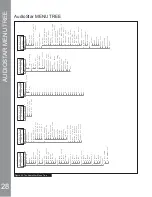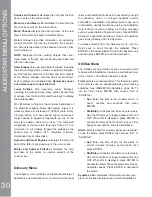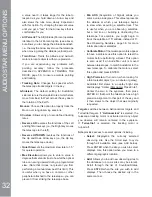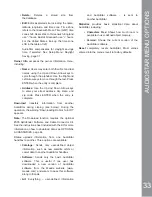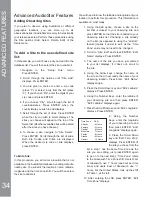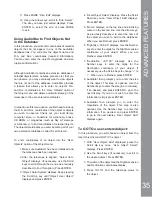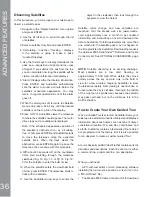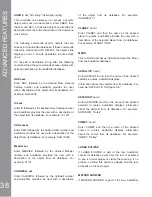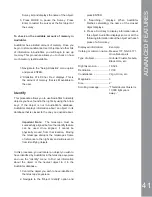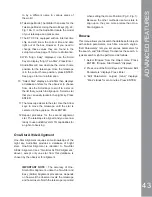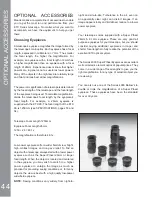
30
Sunrise and Sunset
calculates the time that the Sun
rises or sets on the current date.
Moon rise and Moon set
calculates the time that the
Moon rises or sets on the current date.
Moon Phases
displays the date and time of the next
New, 1st Quarter, Full and 3rd Quarter Moon.
Meteor Showers provides information on upcoming
meteor showers, such as the Perseids, the Leonids,
etc. Also lists the dates of the showers and when they
reach maximum.
NOTE:
Meteors are fast moving objects that cover
large areas of the sky and are usually best observed
with the naked eye.
Solar Eclipse
lists upcoming Solar Eclipses, including
the date and type (total, annular, or partial) of eclipse,
DQGWKHORFDWLRQDQGWLPHRIWKH¿UVWDQGODVWFRQWDFWV
of the Moon’s shadow. Use the Scroll Up and Down
keys to display the available data.
Remember, never
use a telescope to look at the Sun!
Lunar Eclipse
lists upcoming Lunar Eclipses,
including the date and type (total, partial, penumbral)
of eclipse. Use the Scroll Up and Down keys to display
the available data.
Min. (Minimum) of Algol is the minimum brightness of
the dramatic eclipsing binary star system, Algol. It is
relatively close at a distance of 100 light years. Every
2.8 days during a 10 hour period, Algol undergoes a
major change in apparent magnitude as one of the
two stars passes behind the other. The combined
magnitude of the two stars thus dips from +2.1 to a
minimum of +3.4 halfway through the eclipse as the
second star is hidden. ETX calculates minimum
magnitude time at mid-eclipse.
Autumn and Vernal Equinox
calculates the time and
date of the fall or spring equinox of the current year.
Winter and Summer Solstice
calculates the time
and date of the winter or summer solstice of the
current year.
Glossary Menu
The Glossary menu provides an alphabetical listing of
GH¿QLWLRQVDQGGHVFULSWLRQVIRUFRPPRQDVWURQRPLFDO
terms and AudioStar functions. Access directly through
the Glossary menu or through hypertext words
embedded in AudioStar. A hypertext word is any word
in [brackets], usually found when using the AudioStar
Help function or when reading a scrolling message
such as a description of a planet or star. Press ENTER
whenever a hypertext word is on screen and AudioStar
goes to the glossary entry for that word.
To access directly from the Glossary menu, use the
Scroll keys to scroll through the alphabet. Press
ENTER on the desired letter. Scroll to the desired entry
and then press ENTER to read the description.
Utilities Menu
The Utilities menu provides access to several extra
features within AudioStar, including a countdown timer
and an alarm. The Utilities functions include:
Timer
selects a countdown timer. This feature is useful
for functions such as astrophotography and tracking
satellites. See OBSERVING Satellites, page 36. To
use the Timer, press ENTER, then choose “Set” or
“Start/Stop.”
• Set:
Enter the time to be counted down, in
hours, minutes, and seconds, then press
ENTER.
• Start/Stop:
Activates the timer set previously.
Use the Scroll keys to toggle between ON and
OFF. When ON is displayed, press ENTER to
activate the timer. When the timer runs out, four
beeps sound and the timer is deactivated
Alarm:
selects a time for an alarm signal as a reminder.
To use the Alarm, press ENTER, then choose “Set” or
“Start/Stop”.
• Set:
Enter the time of day for the alarm to
sound, in hours, minutes, and seconds, then
press ENTER.
• Start/Stop:
Activates the alarm set previously.
Use the Scroll keys to toggle between ON and
OFF. When ON is displayed, press ENTER to
activate the alarm. When the alarm time arrives,
AudioStar beeps. Press ENTER to deactivate
the alarm.
Eyepiece Calc:
calculates information about an eye-
SLHFHIRUWKHVSHFL¿FWHOHVFRSHWRZKLFK$XGLR6WDULV
AUDIOST
A
R MENU OPTIONS


